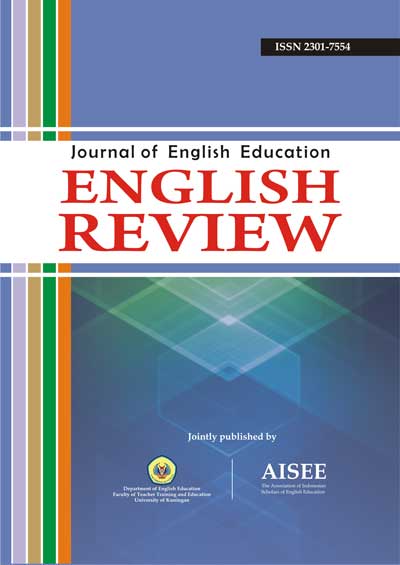TEACHING COMMUNICATIVE TRANSLATION: AN ACTIVE RECEPTION ANALYSIS BETWEEN THE TRANSLATION AND READER'S RECEPTION
Main Article Content
Abstract
Abstract:Â Literary theory sees reception theory from the reader response that emphasizes the reader's reception of a literary text. It is generally called audience reception in the analysis of communications models. In literary studies, reception theory originated from the work of Hans-Robert Jauss in the late 1960s. Communication only means that the original message will be clearly sent in its equivalent context to the target receptor. Similarly, the main role of translators is to send the message across without any form of distortion or emphasis. It is delivering the genuine context of the message to the language that the active receptor understands. A single mistake in a context translation can result to offensive message that can eventually lead to misunderstandings between active receptors. This paper proposes on the role of translator as the mediator between a writer of the original text and the active target language receptors of translated version in the course of communication which definitely affects the process and result of translation practice. It also reveals the emphasis on the creation text of the translation theories originated from the strategic communication theories, which hopefully leads to a dream of the most equivalence between the text and the translated version.
Keywords: translator, active receptor, mediator, strategic communication, equivalence.Â
Article Details
All articles published in English Review: Journal of English Education (ERJEE) are licensed under the Creative Commons Attribution 4.0 International License (CC BY 4.0).
Copyright Ownership
Authors retain the copyright of their articles and grant ERJEE the right of first publication. The journal is granted a non-exclusive license to publish, reproduce, and distribute the article in any format, medium, or platform, provided that proper credit is given to the original authors.
License Terms – CC BY 4.0
Under the Creative Commons Attribution 4.0 International License, others are free to:
- Share — copy and redistribute the material in any medium or format
- Adapt — remix, transform, and build upon the material for any purpose, even commercially
As long as they:
- Provide appropriate credit to the original author(s) and source
- Provide a link to the license (https://creativecommons.org/licenses/by/4.0/)
- Indicate if any changes were made
There are no restrictions on the reuse, reproduction, or adaptation of published articles as long as attribution is properly given.
Author Warranties
By submitting a manuscript to ERJEE, authors confirm that:
- The work is original and does not infringe any existing copyright.
- The manuscript has not been previously published and is not under consideration elsewhere.
- All sources and references are appropriately acknowledged.
- Necessary permissions have been obtained for any copyrighted materials used.
References
Bialystok, E. (1990). Communication strategies: A psychological analysis of second language use. London: Blackwell.
Holub, R. C. (1984). Reception theory: A critical introduction. London: Routledge.
Hymes, D. H. (1971): On Communicative Competence. Philadelphia: University of Pennsylvania Press.
Hymes, D.H. (1972). On Communicative Competence. In J.B. Pride and J. Holmes (Eds.). Sociolinguistics: Selected Readings. Middle sex: Penguin Books.
Iser, W. (1974). The Implied Reader: Patterns of Communication in Prose Fiction from Bunyan to Beckett. Baltimore and London: The Johns Hopkins University Press.
Jauss, H. R. (1982). Toward an Aesthetic of Reception. Trans. Timothy Bahti. Minneapolis: University of Minnesota Press.
Larson, M. L. (1984). Meaning-based translation: A guide to cross-language equivalence. Lanham: University Press of America.
Neubert, A. (2000): “Competence in language, in languages and in translation,†in B. Adab and C. Schaffner (eds.). Developing Translation Competence. Amsterdam: John Benjamins.
PACTE (2000). Acquiring translation competence: Hypotheses and methodological problems of a research project. In A. Beeby, D. Ensinger, M. Presas (eds.). Investigating Translation. 99-106. Amsterdam: John Benjamins.
Procter, J. (2004). Stuart Hall. London: Routledge.
Richards, J. C. and Rodgers, T. (2002). Approaches and methods in language teaching (2nd edition). CUP: United Kingdom.
Richards, J. C. & R. Schmidt (2002). Longman dictionary of language teaching and applied linguistics, London: London Group UK Limited.
Rubin, J. (1981). The study of cognitive processes in second language learning. Applied Linguistics, 1, 117-131.
_______. (1987). Learner Strategies: theoretical assumptions. Research history and typology. In A. Wenden & J. Rubin (Eds.). Learner Strategies in Language Learning. Cambridge: Prentice-Hall.
Rubin, J. and Thompson, I. (1994). How to be a more successful language learner. Boston: Heinle & Heinle Publishers
Wilss, W. (1982). The Science of translation. problems and methods. Tübingen: Gunter Narr.

